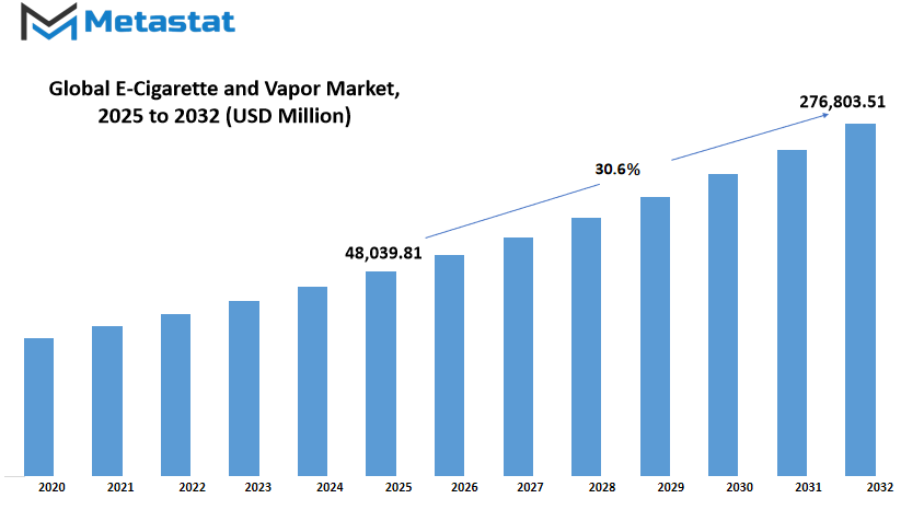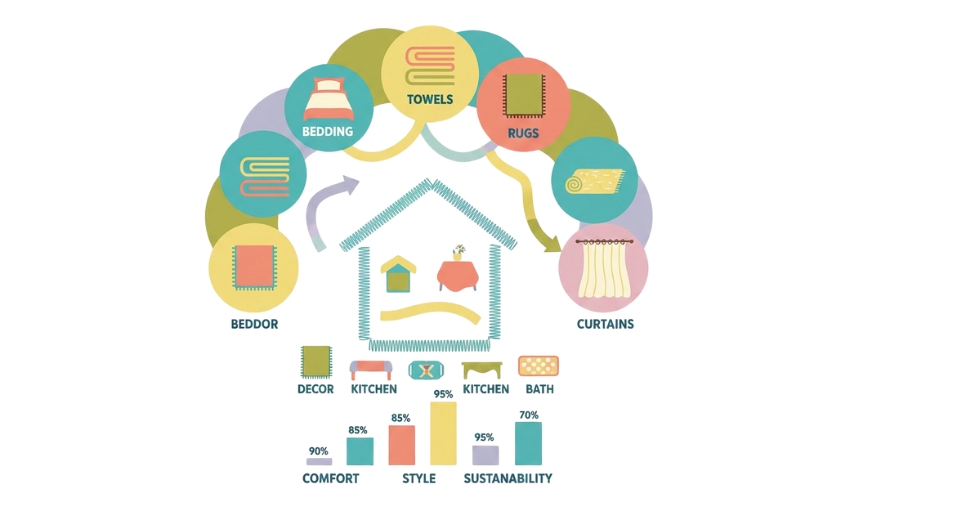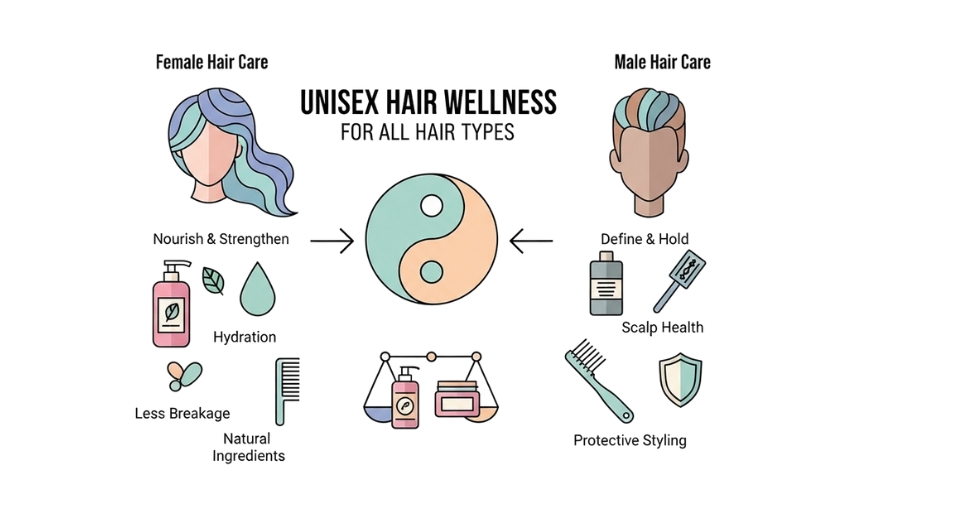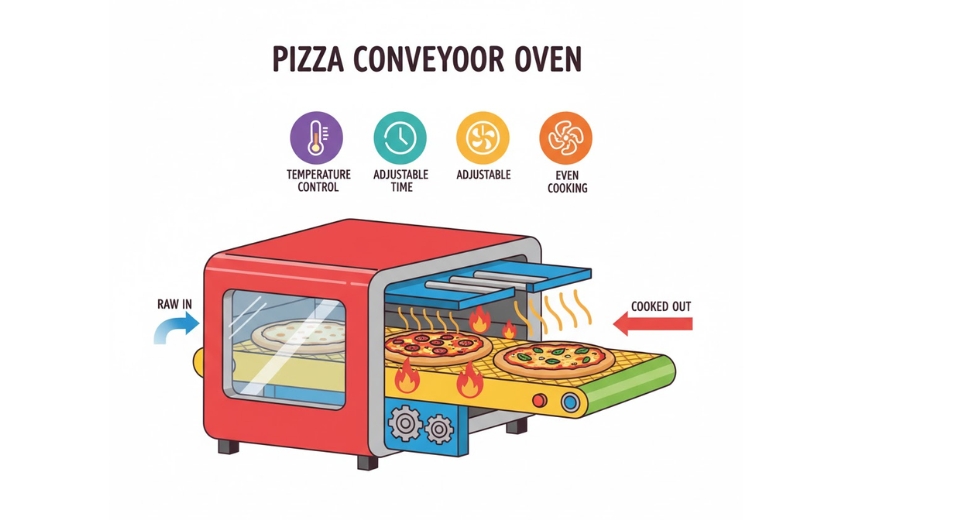MARKET OVERVIEW
The global e-cigarette and vapor products market will start to reshape the way consumers and regulators interact with the delivery of nicotine in the coming decade. The sector stands at a crossroads where innovation in products in terms of devices, changes in societal attitudes, and decisions on regulation in the future will rechart its trajectory. Over the coming years, this sector will be shaped by evolving expectations and a shift in what consumers desire—not merely a replacement for smoking but a complex experience that blends design, personalization, and wellness positioning. To that end, manufacturers will pursue partnerships with lifestyle brands, creating products that resemble tech gadgets rather than medical gadgets.
Consumer electronics manufacturers and design houses will partner, and the lines between fashion object and personal device will begin to blur. Consumers will not only love how something functions but also how it feels to hold, how it communicates personal identity, and how it interfaces with digital systems. Apps can be tied to devices for tracking use patterns or to distribute firmware updates, and subscription models can emerge, in which cartridge delivery and software functionality are bundled together. At the same time, regulators will keep a close eye on how these devices are distributed, to whom, and how their long-term effects may surface. Product creators will experience tighter regulations on flavor descriptor labels, e-commerce advertising, and access to young people—pressures likely to compel organizations to comply and possibly develop new compliance methods. Industry players will respond by embracing more honest labeling of ingredients, relying on third-party testing laboratories, or seeking certifications future consumers will trust. Meanwhile, tiered products will be a go-to method. An entry-level product, relatively affordable and geared towards new users, will be paired with a premium range featuring advanced vapor, variable power outputs, and design nuance. Those who want a richer, more customized experience will gravitate towards the upper tier. That play will drive user retention and create brand narratives of quality and customization.
Channels for distribution will also shift. More grocery stores and pharmacies will stock them, along with specialized vape shops. Online retailers will host augmented reality demos, where consumers can view design options or observe virtual vapor clouds through phone cameras. Standalone stores in urban areas will be occupied by direct-to-consumer brands, where staff can introduce first-time consumers to the product through hands-on experience without high-pressure sales tactics.
Consumer education will be more critical than ever before. Brands will invest in interactive demonstrations, pop-up activities, and digital consultations educating consumers on device care, battery safety, and hygiene cleaning regimens. That will build trust in a world where health conversation is getting louder.
Behind all this, supply chain strategies will evolve. Expect more modular pieces, so that tired-out components can be swapped out rather than the entire product. That will help environmentally aware users and reduce costs for brands on waste. Brands could also explore new battery chemistry or recyclable materials, which will get devices lighter and greener.
The global e-cigarette and vapor products market will become a stage where product elegance, consumer confidence, and ongoing adaptability become more significant than simple novelty. Over the next few years, it will transform into a customer-led market fueled by wise design, conservative marketing, and smart distribution. Its future tale will be less about how quickly it expands, but about how cleverly it aligns with users, devices, and regulation in a changing world.
Global e-cigarette and vapor products market is estimated to reach $276,803.51 Million by 2032; growing at a CAGR of 30.6% from 2025 to 2032.

GROWTH FACTORS
The global e-cigarette and vapor products market will expand in unanticipated ways due to technology, social change, and regulation. More personalization, such as temperature settings and various levels of nicotine, are being provided by device manufacturers. These features will appeal to consumers who seek a more personalized experience. The growth of slim rechargeable devices and sophisticated pod systems also will continue to attract attention and drive market expansion.
Meanwhile, more users will perceive these products as safer than regular cigarettes and thus will opt for them as a harm reduction option. That increasing social acceptability will serve to increase the size of the global e-cigarette and vapor products market. Physical stores will remain relevant, as they allow users to sample different products before purchasing.
But new challenges lie ahead. Regulators will clamp down on rules, particularly on flavored products targeting youths. For instance, recent decisions have shut down popular flavors for their youth appeal. Delays in approvals by agencies such as the FDA will hold up legal product introductions, while unlicensed imports could be a gap filler, introducing uncertainty to market expansion.
Nevertheless, the future will be full of thrilling prospects. With more people buying goods and services online, firms will embrace e-commerce by combining digital media with shop visits, offering customers more choice and convenience. Self-refilling and intelligent devices will also establish new faster-growing niches. If firms concentrate on secure, regulated solutions, they can access new users and unlock new markets.
Picture a decade from now: individuals utilize customized devices, exchanging cartridges at will, and purchasing both online and in nearby stores. Regulations will determine how soon innovations make it to us. If businesses receive approvals sooner and behave responsibly, the international e-cigarette and vapor products market will discover new opportunities to expand. But if delays continue in obtaining approvals and illegal imports prevail, growth could decelerate.
Nonetheless, with improved design, more intelligent sales models, and prudent regulation, the worldwide e-cigarette and vapor products market will fare well in the future with a combination of convenience, customization, and safer options for a large number of individuals.
MARKET SEGMENTATION
By Product
The global e-cigarette and vapor products market is expected to grow steadily as technology advances and consumer preferences continue to shift. Over the years, these products have moved from being simple alternatives to traditional smoking to becoming highly customizable devices that attract a wide range of users. As people look for options that offer convenience, variety, and a potentially reduced health risk compared to traditional tobacco, the industry will keep expanding, bringing with it new opportunities and challenges.
By product type, the market is divided into disposable e-cigarettes, rechargeable e-cigarettes, and modular devices. Disposable e-cigarettes have gained popularity among beginners and casual users because they are easy to use and require no maintenance. They appeal to people who prefer a hassle-free experience, and their compact design makes them a convenient option for those on the go. This segment will likely remain a strong contributor to market growth, especially as manufacturers continue to enhance flavor options and battery performance.
Rechargeable e-cigarettes are another key segment that will keep drawing attention. They allow users to replace cartridges or refill e-liquids, making them a cost-effective choice over time. Their ability to balance affordability with performance has made them a preferred option for regular users. As technology improves, rechargeable devices will likely offer better battery life, more flavor choices, and improved safety features, attracting an even larger customer base.
Modular devices represent the most advanced category in the global e-cigarette and vapor products market. These products allow users to adjust power, airflow, and even temperature, creating a personalized experience that appeals to experienced vapers. While they are more complex and may require some technical understanding, their flexibility and performance make them highly desirable. As innovation continues, modular devices will become more user-friendly, encouraging more consumers to explore this segment.
Looking ahead, the global e-cigarette and vapor products market will be shaped by continuous innovation, stricter regulations, and growing awareness of health considerations. Manufacturers will focus on improving product safety and creating designs that meet the needs of different types of users. Additionally, advancements in battery technology, flavor quality, and device design will push the market forward.
The future of this industry will also be influenced by how well companies balance innovation with responsibility. By investing in research and development, they will create products that are not only appealing but also safer and more efficient. With demand rising across different age groups and regions, the market will keep evolving, offering a mix of simple disposable devices, practical rechargeable options, and high-performance modular systems to meet the diverse preferences of users worldwide.
By Category
The global e-cigarette and vapor products market is growing at a steady pace and will continue to shape how people consume nicotine in the future. Over the last decade, the shift from traditional cigarettes to electronic options has created new opportunities for both consumers and businesses. This growth is driven by increasing awareness of the health risks linked to regular cigarettes, advancements in technology, and the growing popularity of vaping among younger adults. As innovation continues, the market will not only expand but also adapt to the changing needs and preferences of users.
One of the key factors shaping the global e-cigarette and vapor products market is the division of products by category, mainly open and closed systems. Open systems allow users to refill e-liquids manually and customize their devices, offering a more personalized experience. This category is especially popular with experienced users who want greater control over their vaping style, flavors, and nicotine levels. On the other hand, closed systems provide a simpler, ready-to-use option that appeals to beginners and those who prefer convenience. These devices are often sleek, easy to carry, and require less maintenance, which makes them attractive to people who want a hassle-free experience.
Looking ahead, the future of the global e-cigarette and vapor products market will likely be shaped by stricter regulations, ongoing health research, and constant innovation. Companies will continue to explore safer materials, better battery technology, and improved flavor delivery to meet rising demand. Consumer preferences will push brands to focus on products that are both safer and more sustainable. As people become more conscious of environmental issues, the industry will likely see a shift toward recyclable parts and eco-friendly packaging.
Technology will also play a huge role in how the market evolves. Smart vaping devices that allow users to track usage, adjust nicotine levels, or connect to apps could soon become mainstream. At the same time, the availability of a wide range of flavors will keep attracting users, though tighter regulations on marketing and flavor restrictions may influence how brands present their products.
Overall, the global e-cigarette and vapor products market will remain dynamic as it responds to trends in health, technology, and consumer behavior. Open and closed systems will continue to define the market structure, each catering to specific needs. With ongoing research and innovation, vaping is likely to become more advanced, safer, and more personalized, ensuring that this market stays significant in the years ahead.
By Distribution Channel
The global e-cigarette and vapor products market is shaping a new path for the future of the smoking and vaping industry. As more people search for alternatives to traditional tobacco, this market will continue to grow and evolve with changing consumer demands. It is driven by innovation, health awareness, and shifting lifestyles, creating opportunities for brands to reach wider audiences. With growing attention on harm reduction and customizable experiences, the market will likely see even more advanced products designed to meet individual preferences.
One of the key factors that will drive the global e-cigarette and vapor products market is the steady development of distribution channels. The market is divided into two main segments: offline and online. Offline channels, which include convenience stores, supermarkets, and specialty shops, will remain significant because they allow customers to see products in person before buying. Many first-time users still prefer the face-to-face interaction and guidance they receive in physical stores. These offline spaces also help build trust between brands and consumers, especially when explaining new devices or flavors.
On the other hand, the online channel will experience faster growth due to its convenience and wide range of choices. E-commerce platforms will make it easier for users to compare products, read reviews, and explore options that may not be available in local stores. This channel also opens doors for global access, allowing brands to reach markets beyond their local reach. With advancements in digital marketing and secure payment options, online sales will continue to expand, particularly among younger and tech-savvy buyers. Subscription models and personalized recommendations online will also strengthen customer loyalty and create a more seamless shopping experience.
Looking ahead, technology will play a big role in shaping the global e-cigarette and vapor products market. Devices will become more advanced, offering better battery life, smart sensors, and improved safety features. Flavors and nicotine levels will also be refined to cater to different preferences, and regulations will likely influence how products are marketed and sold. Brands that focus on transparency and quality will stand out, as consumers become more informed and selective.
The balance between offline and online distribution will continue to define how the market grows. While physical stores will keep attracting buyers who want personal assistance, online platforms will dominate for those seeking variety, convenience, and quick access. Together, these channels will support the ongoing expansion of the market, making it a vital part of the future of modern consumer habits.
|
Forecast Period |
2025-2032 |
|
Market Size in 2025 |
$48,039.81 million |
|
Market Size by 2032 |
$276,803.51 Million |
|
Growth Rate from 2025 to 2032 |
30.6% |
|
Base Year |
2024 |
|
Regions Covered |
North America, Europe, Asia-Pacific Green, South America, Middle East & Africa |
REGIONAL ANALYSIS
The global e-cigarette and vapor products market is steadily growing and will continue to expand in the years ahead, driven by changing lifestyles, rising awareness of alternatives to traditional tobacco, and rapid advancements in technology. This market is shaped by regional preferences and regulations, which create unique patterns of demand and innovation. Understanding the geographic distribution of this growth helps explain how different areas are contributing to the market’s future direction.
In North America, which includes the U.S., Canada, and Mexico, the demand for e-cigarettes and vapor products is expected to remain strong due to the popularity of innovative devices and the increasing acceptance of vaping among younger adults. The U.S. market, in particular, will continue to influence global trends as companies invest in research and marketing strategies that appeal to diverse consumer groups. Canada and Mexico are also gaining momentum as awareness spreads and regulations become clearer, creating a stable environment for growth.
Europe, made up of countries such as the UK, Germany, France, Italy, and the Rest of Europe, is witnessing a rise in demand fueled by supportive legislation and growing interest in smoke-free alternatives. The UK remains a key player, with its emphasis on vaping as a tool for reducing cigarette use. Germany and France are following closely, where innovation and the availability of a wide range of products will shape buying patterns in the coming years.
Asia-Pacific, which includes India, China, Japan, South Korea, and other regional markets, is projected to see the fastest growth. China will continue to lead due to its strong manufacturing base and expanding consumer demand, while Japan and South Korea will see steady increases driven by advanced technology and rising interest in high-quality vapor products. India, with its large population, shows potential but will depend on how regulations evolve.
In South America, with Brazil, Argentina, and the Rest of the region, the market is still developing but will grow as awareness of e-cigarettes spreads and product availability increases. Meanwhile, the Middle East & Africa, which includes GCC Countries, Egypt, South Africa, and other nations, is also on a growth path. GCC countries are expected to lead in this region due to their high spending power and early adoption of new technologies.
Looking ahead, the global e-cigarette and vapor products market will keep changing as technology advances and consumer preferences shift. Each region’s pace of growth will vary, but together they will shape a market that is larger, more diverse, and more innovative than ever before.

COMPETITIVE PLAYERS
The global e-cigarette and vapor products market is shaping a future that reflects rapid innovation, shifting consumer preferences, and intense competition among well-known industry leaders. As more individuals explore alternatives to traditional tobacco, the demand for devices and products that offer convenience, customization, and a wide range of flavors continues to grow. This shift is not just about personal choice but also about technological advancement, as companies are investing heavily in research and development to meet the needs of a diverse and expanding customer base.
Key players such as JUUL Labs Inc., British American Tobacco, Philip Morris International, Japan Tobacco International, and Altria Group have been pivotal in driving this market forward. These companies are not only shaping product design but also influencing regulations and market standards globally. Alongside these giants, other notable names like Imperial Brands, NJOY LLC, Vaporesso (SMOORE), Innokin Technology, GeekVape, Eleaf, Voopoo (Woody Vapes), Aspire, International Vapor Group, J Well France, Joyetech, Kaival Brands Innovations Group, NicQuid, Puff Bar, R.J. Reynolds Vapor Company, Shenzhen IVPS Technology (SMOK), Shenzhen KangerTech, and YouMe Co. are competing aggressively to capture consumer attention through innovation and brand loyalty.
Looking ahead, the global e-cigarette and vapor products market will continue to evolve as companies focus on improving battery life, enhancing flavor delivery, and creating safer, more efficient devices. The integration of smart technology in vaping devices, such as app connectivity and customizable usage settings, is expected to attract tech-savvy users and strengthen customer retention. Additionally, as public awareness around health and wellness grows, there will be greater demand for products that promise lower risks compared to combustible cigarettes.
Regulatory changes will also shape the future of this market. While stricter rules in some regions may slow expansion, they will also push companies to create more compliant, higher-quality products. Competitive players will need to balance innovation with responsibility, ensuring their products meet safety standards while still appealing to consumers.
The role of branding and customer experience will remain crucial. Companies that build trust and deliver consistent performance are more likely to secure a lasting place in the market. With technology advancing and global distribution expanding, the opportunities are significant for those willing to adapt and innovate. In the coming years, the global e-cigarette and vapor products market will not only grow in size but also in sophistication, offering consumers better choices while setting new standards for quality and safety.
E-Cigarette and Vapor Products Market Key Segments:
By Product
- Disposable E-Cigarettes
- Rechargeable E-Cigarettes
- Modular Devices
By Category
- Open
- Closed
By Distribution Channel
- Offline
- Online
Key Global E-Cigarette and Vapor Products Industry Players
- JUUL Labs Inc.
- British American Tobacco
- Philip Morris International
- Japan Tobacco International
- Altria Group
- Imperial Brands
- NJOY LLC
- Vaporesso (SMOORE)
- Innokin Technology
- GeekVape
- Eleaf
- Voopoo (Woody Vapes)
- Aspire (Shenzhen Eigate Technology Co.)
- International Vapor Group
- J Well France
- Joyetech
- Kaival Brands Innovations Group
- NicQuid
- Puff Bar
- R.J. Reynolds Vapor Company
- Shenzhen IVPS Technology Co., Ltd. (associated with SMOK)
- Shenzhen KangerTech Technology Co., Ltd.
- YouMe Co., Ltd.
WHAT REPORT PROVIDES
- Full in-depth analysis of the parent Industry
- Important changes in market and its dynamics
- Segmentation details of the market
- Former, on-going, and projected market analysis in terms of volume and value
- Assessment of niche industry developments
- Market share analysis
- Key strategies of major players
- Emerging segments and regional growth potential








 US: +1 3023308252
US: +1 3023308252






